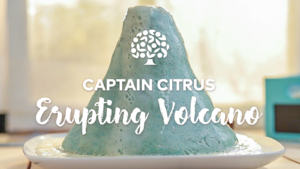
While this is a fun and easy (but also messy!) kitchen experiment, there is so much science going on! Below are a few suggestions and questions to start the conversation about the science behind the volcanic eruption!
Observation: Describing what you see is key in science!
Before putting each ingredient into the volcano (water, detergent, baking soda, orange juice), make some observations about the ingredient. These are also called physical properties.
- Is it a solid or a liquid?
- What color is it?
- What does it smell like?
- How much are we using?
What happens when you add the orange juice?
- What do you see?
- What do you hear?
- What do you smell?
- How does it feel?
What is different about what comes out of the volcano as compared to what you put in?
Hypothesis: Trying to explain what happened.
What do you think causes the bubbles and foam?
Experiment: Testing your Hypothesis.
How could we test to see if your hypothesis is correct?
In smaller amounts, pick 2 of the ingredients and add them together. Describe what you see. Do this with all possible combinations. (water and baking soda, water and detergent, water and orange juice, detergent and baking soda, detergent and orange juice, orange juice and baking soda)
Which of the above mixtures act most like the volcano and show a reaction?
What You Need:
- 1 – 2 cups 100% Orange Juice
- 2 – 4 cups warm water
- Pinch of powder detergent
- 1 tbsp. baking soda
- Salt dough volcano
- 6 cups flour
- 2 cups salt
- 4 tablespoons cooking oil
- 2 cups warm water
Instructions:
1. Create a salt dough volcano by mixing all of its ingredients in a bowl.

2. Fill your volcano ¾ full with warm water.
3. Add powder detergent.

4. Add baking soda

5. When you are ready to start the eruption, slowly pour Florida Orange Juice into your volcano until the “lava” starts foaming out of the top. Once the lava starts foaming, stop pouring the Florida Orange juice.

Helpful Tip:
- Kids can create additional eruptions by adding more baking soda and Florida Orange Juice.
- Make a funnel out of paper to allow for easy pouring of your ingredients.
Conclusion: Decide whether your hypothesis is correct.
If your hypothesis was wrong, that is perfectly fine! You just need to use the results from your experiment to explain it was wrong. Then, make a new statement (conclusion) on what is happening based on your results. This is just how science works!
What is happening in this experiment?
The baking soda reacts with the orange juice to produce carbon dioxide (CO2) gas. This is a chemical reaction in which both the baking soda and orange juice go through chemical changes. The starting materials (or reactants) were in solid and liquid form, and one of the products from the reaction is in the gas form.
Baking soda is the common name for sodium bicarbonate (NaHCO3) which is a base and will produce CO2 gas when it is combined with an acid like orange juice or vinegar. The gas expands and builds up enough pressure to force the liquid out of the top of the volcano. The mixture of the gas and the liquid produces the foam.
The water and detergent in this experiment are not part of the chemical reaction, but help us to better observe what is going on and make the experiment more exciting. The water helps to dissolve the baking soda so it may react with the orange juice and produce more foam. The detergent helps to trap the gas so that the foam flows down the side of the volcano. Generally, gases, like the air we breathe, are colorless and if not trapped in some way, we are not able to see them with our eyes.


